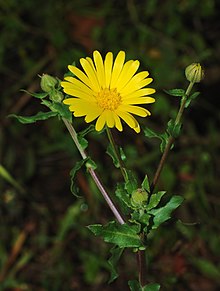Calendula arvensis
| Calendula arvensis | |
|---|---|

| |

| |
| Scientific classification | |
| Kingdom: | Plantae |
| Clade: | Tracheophytes |
| Clade: | Angiosperms |
| Clade: | Eudicots |
| Clade: | Asterids |
| Order: | Asterales |
| Family: | Asteraceae |
| Genus: | Calendula |
| Species: | C. arvensis
|
| Binomial name | |
| Calendula arvensis | |
| Synonyms[2] | |
|
List
| |

Calendula arvensis is a species of flowering plant in the daisy family known by the common name field marigold. It is native to central and southern Europe, and it is known across the globe as an introduced species.[3][4]
Calendula arvensis is an annual or biennial herb 10 to 50 cm (3.9 to 19.7 in) tall. The leaves are lance-shaped and borne on petioles from the slender, hairy stem. The inflorescence is a single flower head up to four centimeters wide with bright yellow to yellow-orange ray florets around a center of yellow disc florets. The fruit is an achene which can take any of three shapes, including ring-shaped, that facilitate different methods of dispersal.[5][6]
Achene[edit]
Calendula arvensis produce three types of achenes (fruits of the sunflower family), they are rostrate, cymbiform and annular. Rostrate and cymbiform are suitable for long-distance diffusion, because they have larger size and weight than annular, while annular is suitable for short-distance diffusion.[7]
References[edit]
- ^ Linnaeus, Carl (1763). Species plantarum (2 ed.). p. 1303.
- ^ "Calendula arvensis L." Plants of the World Online. Royal Botanic Gardens, Kew. Retrieved 23 March 2022.
- ^ Flora of North America, Calendula arvensis Linnaeus, Sp. Pl. Ed. 2,. 2: 1303. 1763.
- ^ Altervista Flora Italiana, Fiorrancio dei campi Calendula arvensis (Vaill.) L. includes photos and European distribution map
- ^ Ruiz de Clavijo, E. (2005). The reproductive strategies of the heterocarpic annual Calendula arvensis (Asteraceae). Acta Oecologica 28:2 119-26.
- ^ Messina, Nino (2010). "Calendula arvensis". Actaplantarum. Archived from the original on 25 March 2015. Retrieved 21 January 2015.
- ^ Ruiz De Clavijo, E. (2005-09-01). "The reproductive strategies of the heterocarpic annual Calendula arvensis (Asteraceae)". Acta Oecologica. 28 (2): 119–126. doi:10.1016/j.actao.2005.03.004. ISSN 1146-609X.
External links[edit]
- Jepson Manual Treatment
- Calendula arvensis in the CalPhotos photo database, University of California, Berkeley
